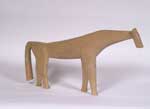VAM galleries including this work:
Kentucky Folk Art Center | Animal Farm || VAM Home
Garland Adkins (Kentucky, 1928-1997)
HORSE, 1987
Wood; 13-1/2" X 27-1/2" X 4"
1989.4.15
Kentucky Folk Art Center
This carved wooden sculpture clearly depicts a horse. But even though the figure can be easily identified, it is not a realistic representation. The figure has been simplified and stylized; its legs and tail are too thick. Yet it is immediately recognizable as a horse. In capturing the essence of the animal, Adkins has achieved a universality, creating a horse form that denies the time and place in which it was made. This piece could have been produced in a quite different culture at an entirely different time.
About the Artist
In 1952, Garland Adkins moved from Kentucky to Fairborn, Ohio, to find work. There he worked in carpentry and general construction. After he and wife Minnie raised their son, Mike, the couple returned to Isonville in Eastern Kentucky’s Elliott County in the mid-1970s.
Minnie Adkins had carved small animal figures for many years, and Garland had assisted her with various parts of the process for some time. (Their work was signed “G&M Adkins.”) Minnie’s growing success in the early 1980s prompted Garland to try his hand, and his solo efforts met with almost immediate success. Garland Adkins’ work is now part of several museum collections and has been included in numerous exhibitions. He is best known for his horse sculptures, whose timeless quality and universal appeal gained the artist widespread recognition and acclaim.
Garland Adkins died of cancer in 1997.
Classroom Ideas
Discussion: Describe Horse. How did the artist use the elements of art in this piece? How do you think the artist feels about horses? Do you think this piece conveys the spirit of a horse? How? Compare this piece to other works showing horses from the Kentucky Virtual Art Museum. (The International Museum of the Horse and Kentucky Derby Museum galleries both include images of horses.) Compare this work to other folk art animals in our collection, such as Minnie Adkins’ Fox, Minnie Black’s Bulldog, and Linvel Barker’s Sitting Cat from the Kentucky Folk Art Center. How does the inclusion or lack of detail help convey the animal?
Activities: Draw a horse or other animal that interests you, using basic shapes and conveying few details. Create another drawing that is more detailed. Which drawing do you like better? Why?
Create an animal soap carving. First, make or find a drawing of an animal that clearly shows the outline of its body or head. Using a copier, reduce the drawing until it is small enough to fit the surface of a family-size bar of unscented bath soap. Tape the drawing to the bar of soap. Use the end of an unfolded paper clip to trace the image by punching holes along the edge of the drawing, then remove the taped image. Working from the outside inward, slowly carve away slivers of soap using pointed wooden craft sticks. Work carefully and gradually. Do not attempt to carve away large pieces, as the soap is brittle and could possibly break. Continue carving until the soap is carved away to the outline of the animal.
Links
See a photographic portrait of Garland Adkins in the Smithsonian Institution’s Archive of American Art.
[artarchives.si.edu/exhibits/rosenak/adkins.htm]
Read an article about Minnie and Garland Adkins and see images of their work at the Self-Taught Folk Art web site.
[alumnus.caltech.edu/~dacrotty/adkins.html]
The Jane’s Addictions site includes more examples of work by the Adkinses.
[www.janesaddictions.com/adkins01.htm]


